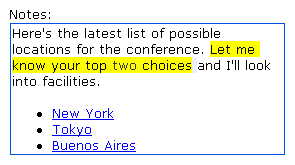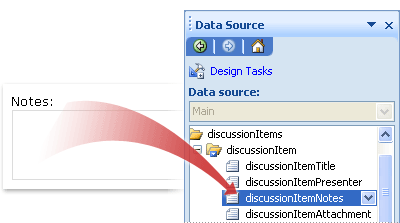How to Upload a Rich Text Document Into Roll20
If you want users to be able to insert formatted text, paragraph breaks, tables, photographs, or clip art in a information-entry field, you can use a rich text box on your Microsoft Office InfoPath form template.
In this article
-
When to apply a rich text box
-
The user experience
-
Compatibility considerations
-
Insert a rich text box
-
Layout tips
When to use a rich text box
Use a rich text box when y'all want to:
-
Enable users to highlight, emphasize, or format the text that they type into a class.
-
Enable users to insert tables or pictures in a bare area on the class.
-
Display rich-text information contained in a database or other source of data.
-
Store formatted data as XHTML in the course template'south underlying data source.
In the following illustration, a rich text box is used to collect detailed notes from users.

Related controls
InfoPath includes controls that are similar to rich text boxes only that serve unlike purposes. To determine which of these controls works all-time on your form template, refer to the following list:
Text box Like a rich text box, a text box allows users to type, edit, or view text. Dissimilar a rich text box, a text box displays but a single line of text by default, and users cannot add formatting elements to a text box, such equally bold or italic text, pictures, or tables.
Expression box An expression box is generally used to brandish read-only text, to brandish the value of another command on the course template, or to create formulas that are based on XPath expressions. Different a rich text box, an expression box does non store or save information. Therefore, you should use an expression box only if you don't desire to save its value or reference it in another formula.
Height of Page
The user feel
Like a text box, a rich text box is simply a placeholder on a class, such as a comments box, in which users enter text. When typing text in a rich text box, users have admission to many of the formatting features that they are accustomed to using in other Microsoft Role system documents. For case, users tin can insert a motion picture or table in a rich text box or utilize yellow highlighting to a detail paragraph of text.
To observe out if they can format text in a item field on a form, users place their cursor in the field or select the text in the field. If options on the Formatting toolbar are active instead of dimmed, the users can format the text simply every bit they would in whatsoever other Microsoft Role system document.
Top of Folio
Compatibility considerations
When y'all design a form template in InfoPath, you tin choose a specific compatibility mode to design a browser-uniform form template. When a browser-compatible course template is published to a server running InfoPath Forms Services, and and so browser-enabled, forms based on the form template tin be viewed in a Web browser. When you design a browser-compatible course template, some controls are unavailable in the Controls task pane because they cannot be displayed in a Web browser.
Although rich text boxes are bachelor when you lot design a browser-compatible class template, be enlightened of the following limitations:
-
Partial rich-text formatting is not supported in the browser version of the rich text box. If you see an mistake near incompatible rich-text settings in the Design Checker job pane, select the Enable browser-compatible settings only bank check box in the Rich Text Box Properties dialog box. Doing so automatically selects the correct rich-text settings for you lot.
-
You tin can enable linked pictures for a rich text box in a browser-compatible form template. However, embedded pictures are not supported.
-
For rich text boxes, the full range of formatting options are bachelor only in supported versions of Internet Explorer, including Microsoft Internet Explorer half dozen.0 and Windows Internet Explorer 7.0. It is possible for users to edit text in a rich text box in other supported browsers, such as Firefox 1.5 or Safari 2.0, but formatting options are unavailable, including changing the text color and applying graphic symbol formatting.
Pinnacle of Folio
Insert a rich text box
The procedure for inserting a rich text box differs slightly depending on whether yous are designing a new, blank class template or basing the design of your form template on a database or other external information source.
The post-obit illustration shows how a rich text box looks when it is selected in design mode.

Controls can be bound or unbound. When a control is bound, it is connected to a field or group in the information source so that data entered into the command is saved in the underlying class (.xml) file. When a command is unbound, it is not continued to a field or grouping, and information entered into the command is not saved. When you select or movement your pointer over a command, text and a binding icon appear in the upper-correct corner of the control. The text indicates the group or field to which the control is bound in the information source. The icon indicates whether the control is correctly bound to that grouping or field. When the binding is correct, a light-green icon appears. If in that location'south something incorrect with the binding, you'll see a bluish or red icon instead.
The data source for the form template consists of fields and groups that appear in a hierarchical view in the Data Source chore pane. Rich text boxes are ever spring to fields. In the following instance, the Notes box on the form is bound to the discussionItemNotes field in the Data Source task pane.

Insert a rich text box on a new, bare form template
When you lot pattern a new, bare class template, the Automatically create information source check box in the Controls task pane is selected by default. This enables InfoPath to automatically create fields and groups in the data source equally yous add controls to the form template. These fields and groups are represented by binder and file icons in the Information Source task pane.
-
On the form template, identify the cursor where you want to insert the command.
-
If the Controls task pane is not visible, click More Controls on the Insert menu, or press ALT+I, C.
-
Under Insert controls, click Rich Text Box.
-
To specify the type of rich text that users tin can enter, double-click the rich text box that was inserted on the grade template, click the Brandish tab, and so select or clear the check boxes nether Available formatting.
-
To add a label to the command, blazon text to a higher place or to the left of the control, followed by a colon (:).
Insert a rich text box on a course template that is based on an existing data source
If you base of operations the blueprint of your form template on an existing Extensible Markup Language (XML) file, database, or Web service, InfoPath derives the fields and groups in the Data Source chore pane from that existing data source. In this scenario, yous can insert a rich text box by dragging a field from the Data Source task pane onto the form template or by inserting a rich text box from the Controls task pane instead, as described in the following procedure:
-
On the course template, place the cursor where you want to insert the command.
-
If the Controls task pane is non visible, click More Controls on the Insert menu, or press ALT+I, C.
-
Under Insert controls, click Rich Text Box.
-
In the Rich Text Box Bounden dialog box, select the field in which yous want to store rich text box data, and so click OK.
-
To specify the type of rich text that users can enter, double-click the rich text box that was inserted on the class template, click the Brandish tab, then select or clear the bank check boxes nether Available formatting.
-
InfoPath uses the name of the field or group as the control'southward label. If necessary, alter the label text.
Tip:You tin as well employ the Information Source chore pane to insert controls. In the Data Source task pane, right-click the field that you want to demark the rich text box to, and then click Rich Text Box on the shortcut bill of fare.
Elevation of Page
Layout tips
Utilise the following tips to help you refine the appearance, size, and other aspects of a rich text box:
-
To change the size of several rich text boxes at once, select the rich text boxes whose size you want to change, on the Format carte, click Properties, click the Size tab, and and then make the necessary adjustments.
-
To subtract the default width at which InfoPath inserts rich text boxes, click View Properties on the View menu. On the General tab, select the Apply a custom layout width for this course template check box, and then type a smaller number in the Custom layout width box.
-
To alter the border or color of several rich text boxes at once, select the rich text boxes that you want to change, on the Format bill of fare, click Borders and Shading, click the Borders tab, and so make the necessary adjustments.
-
To customize the text that appears in a rich text box, use the Font and Font Size boxes on the Formatting toolbar. To modify the font and font size for all of the rich text boxes on your form template at once, select the rich text box that contains the formatting that y'all want, and so click Apply Font to All Rich Text Box Controls on the Format carte du jour.
-
To see what your rich text boxes will wait like with actual text in them, click Sample Information on the View menu. This helps you get a sense of what the form will look similar when users make full information technology out.
-
Use margins to suit the spacing around the exterior of a rich text box. Use padding to arrange the spacing effectually the text within the rich text box.
Summit of Page
Source: https://support.microsoft.com/en-us/office/insert-a-rich-text-box-0e3ec637-b9e2-4de6-9e36-a2641d7629d9